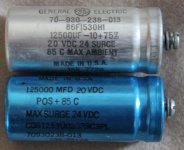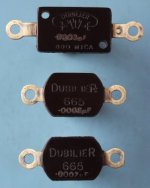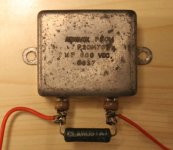RobS
Experienced Member
Here's a photo of two capacitors that I removed from two identical eight inch diskette drive power supplies out of a couple of Honeywell Level 6 minicomputers. I was modifying the PSUs to use on my Honeywell 200 project and didn't need these components, but I noticed something about them. They were made by General Electric and Plessey and both have the part number 70930238-013 but one is marked 12500UF and the other 125000MFD, which is ten times the capacity where I come from. Now is this a relativistic effect where one has travelled at great speed, maybe from a galaxy far far away where the manufacturing technology is much more advanced or can we just not trust manufacturers' own labelling? When working on vintage equipment without the benefit of a schematic one has to have some faith in manufacturers' markings, but this has got me a little paranoid. Perhaps a batch were incorrectly marked and Honeywell got them on the cheap or didn't care as they went by the part numbers. Has anyone else encountered this problem? I haven't bothered to check their actual capacities but the truth is out there.
They were made by General Electric and Plessey and both have the part number 70930238-013 but one is marked 12500UF and the other 125000MFD, which is ten times the capacity where I come from. Now is this a relativistic effect where one has travelled at great speed, maybe from a galaxy far far away where the manufacturing technology is much more advanced or can we just not trust manufacturers' own labelling? When working on vintage equipment without the benefit of a schematic one has to have some faith in manufacturers' markings, but this has got me a little paranoid. Perhaps a batch were incorrectly marked and Honeywell got them on the cheap or didn't care as they went by the part numbers. Has anyone else encountered this problem? I haven't bothered to check their actual capacities but the truth is out there.
 They were made by General Electric and Plessey and both have the part number 70930238-013 but one is marked 12500UF and the other 125000MFD, which is ten times the capacity where I come from. Now is this a relativistic effect where one has travelled at great speed, maybe from a galaxy far far away where the manufacturing technology is much more advanced or can we just not trust manufacturers' own labelling? When working on vintage equipment without the benefit of a schematic one has to have some faith in manufacturers' markings, but this has got me a little paranoid. Perhaps a batch were incorrectly marked and Honeywell got them on the cheap or didn't care as they went by the part numbers. Has anyone else encountered this problem? I haven't bothered to check their actual capacities but the truth is out there.
They were made by General Electric and Plessey and both have the part number 70930238-013 but one is marked 12500UF and the other 125000MFD, which is ten times the capacity where I come from. Now is this a relativistic effect where one has travelled at great speed, maybe from a galaxy far far away where the manufacturing technology is much more advanced or can we just not trust manufacturers' own labelling? When working on vintage equipment without the benefit of a schematic one has to have some faith in manufacturers' markings, but this has got me a little paranoid. Perhaps a batch were incorrectly marked and Honeywell got them on the cheap or didn't care as they went by the part numbers. Has anyone else encountered this problem? I haven't bothered to check their actual capacities but the truth is out there.


